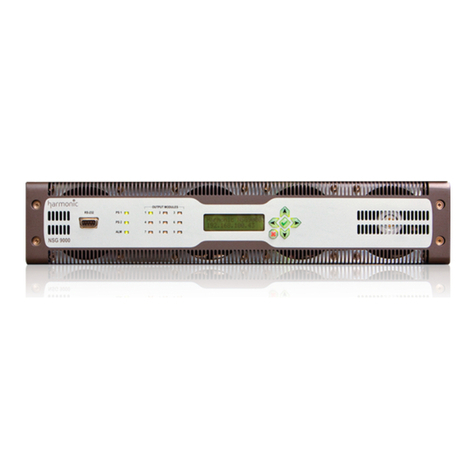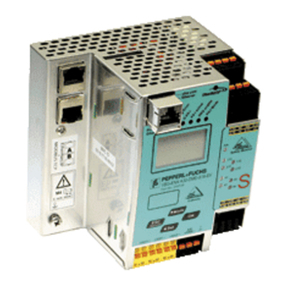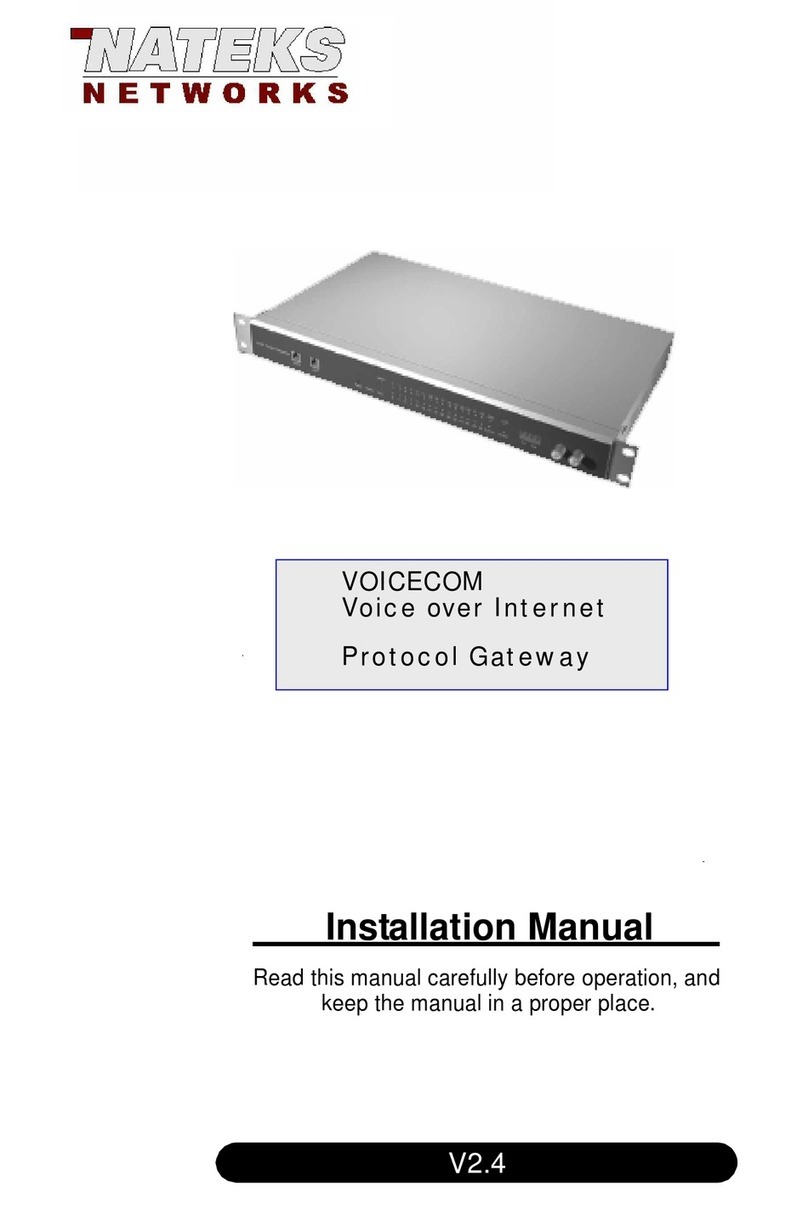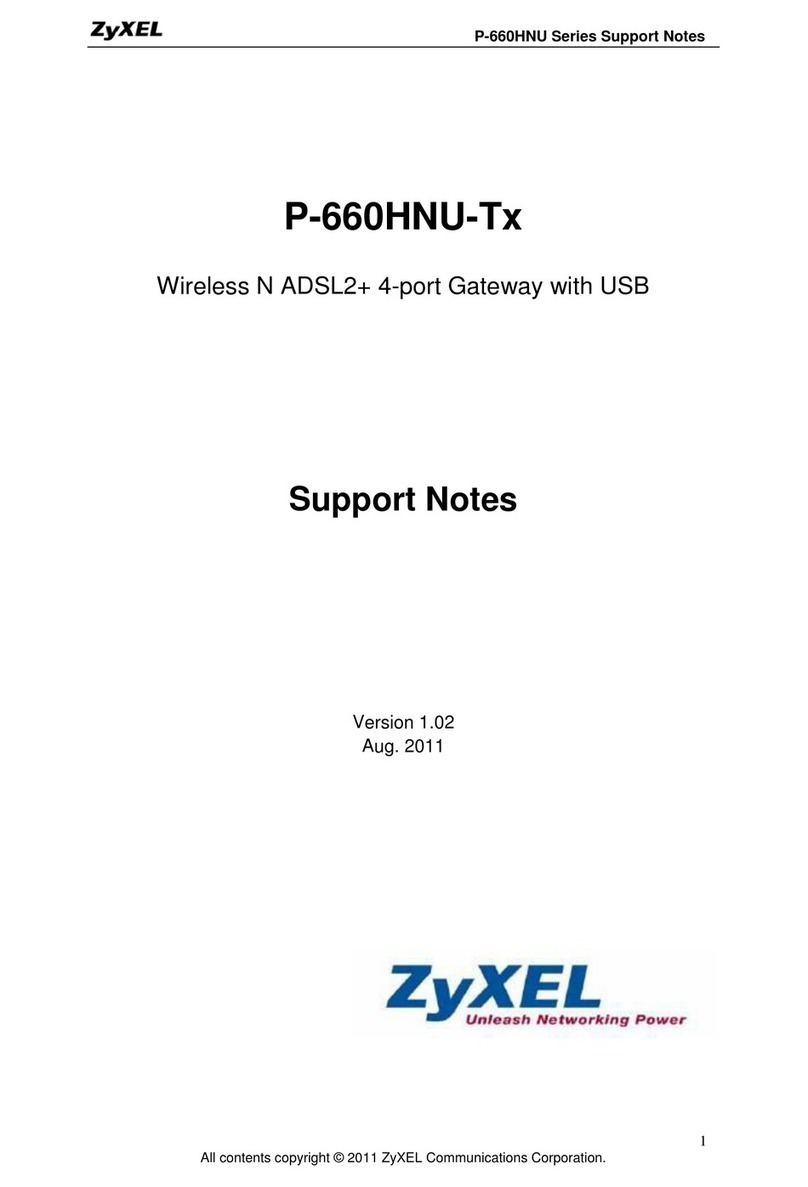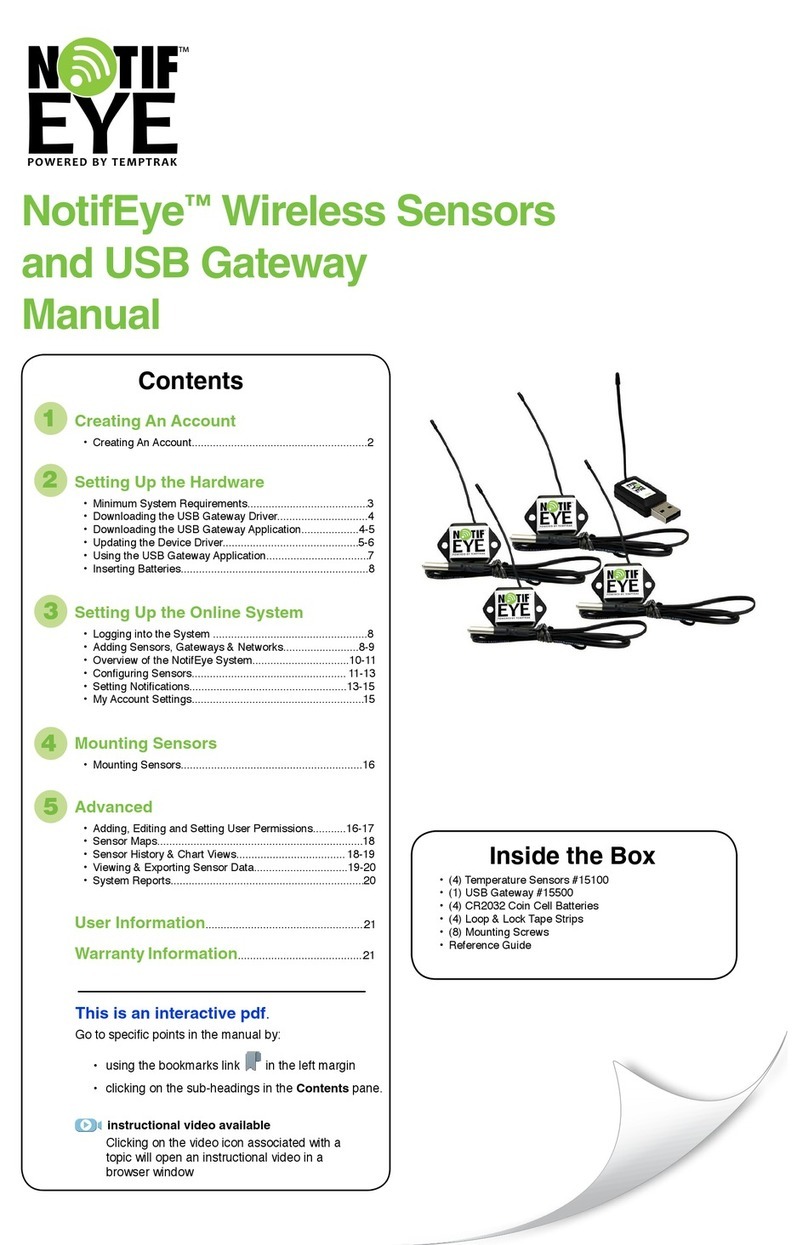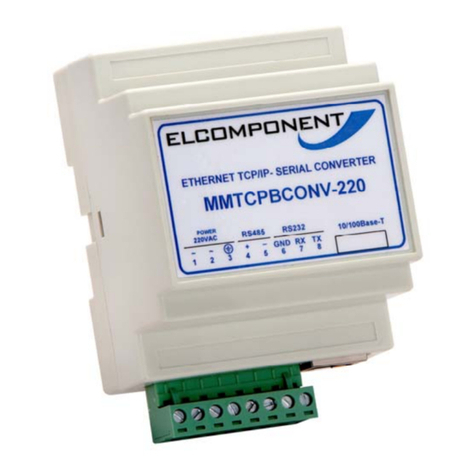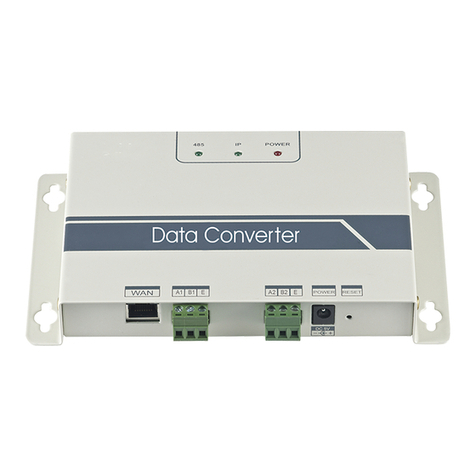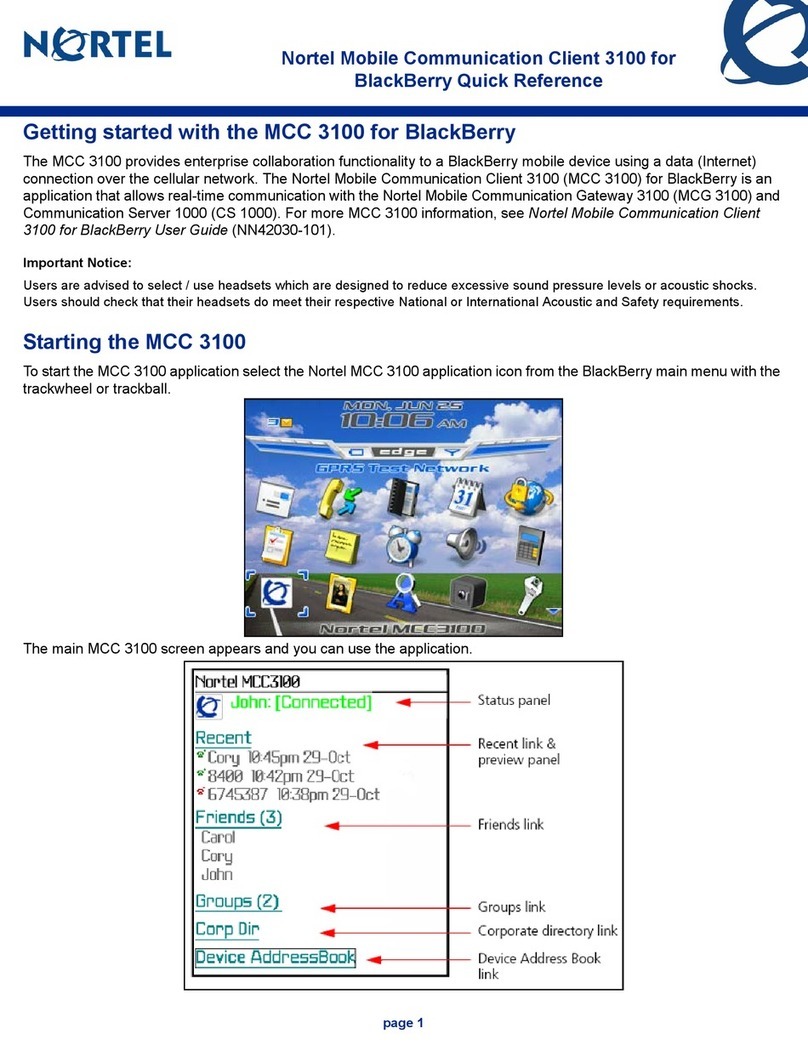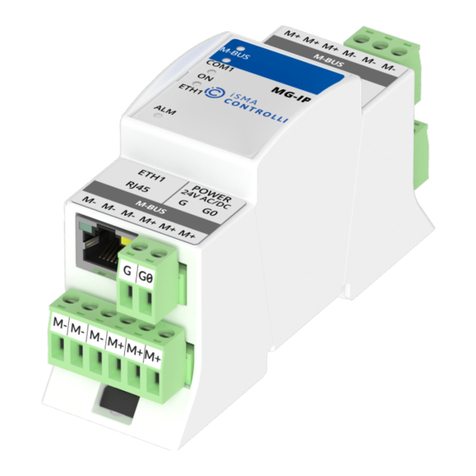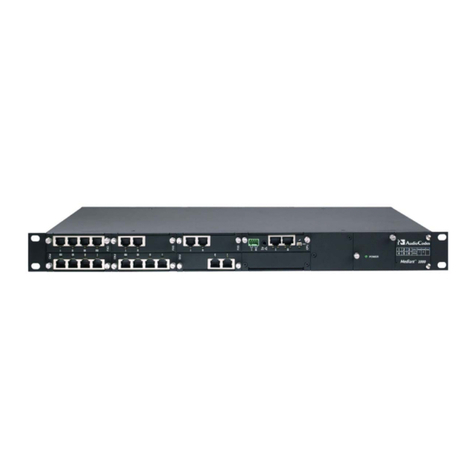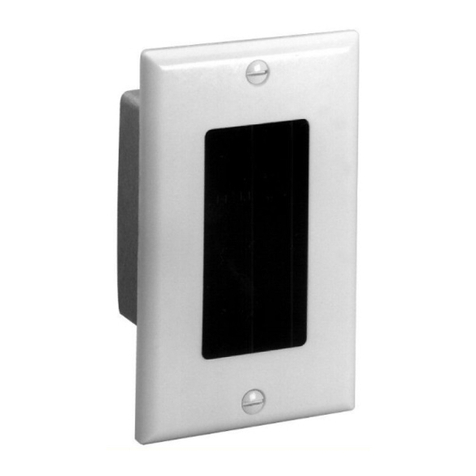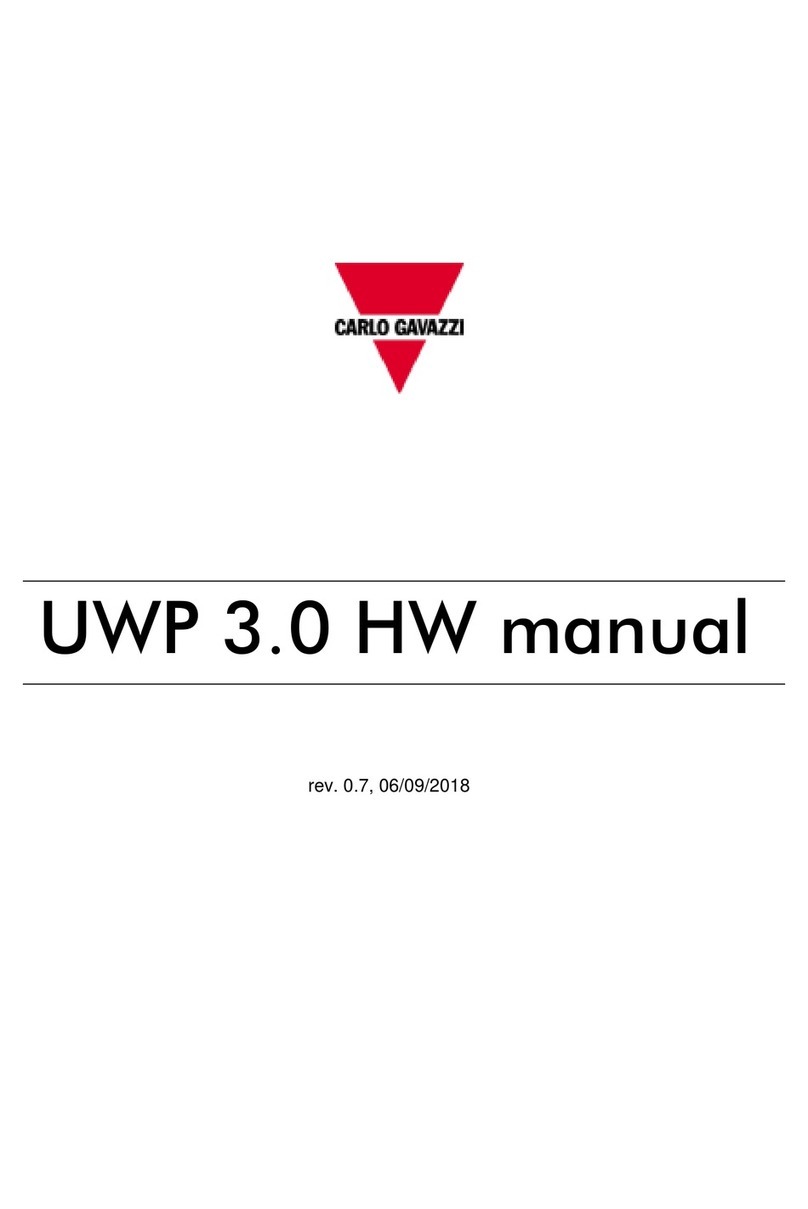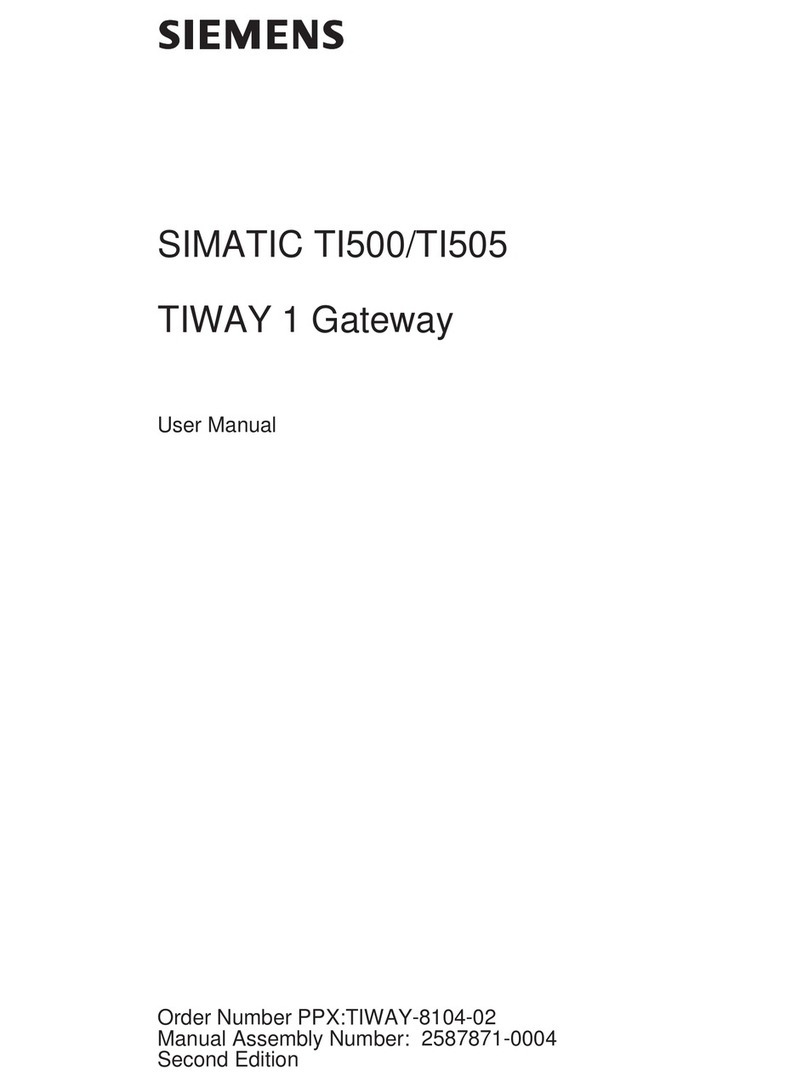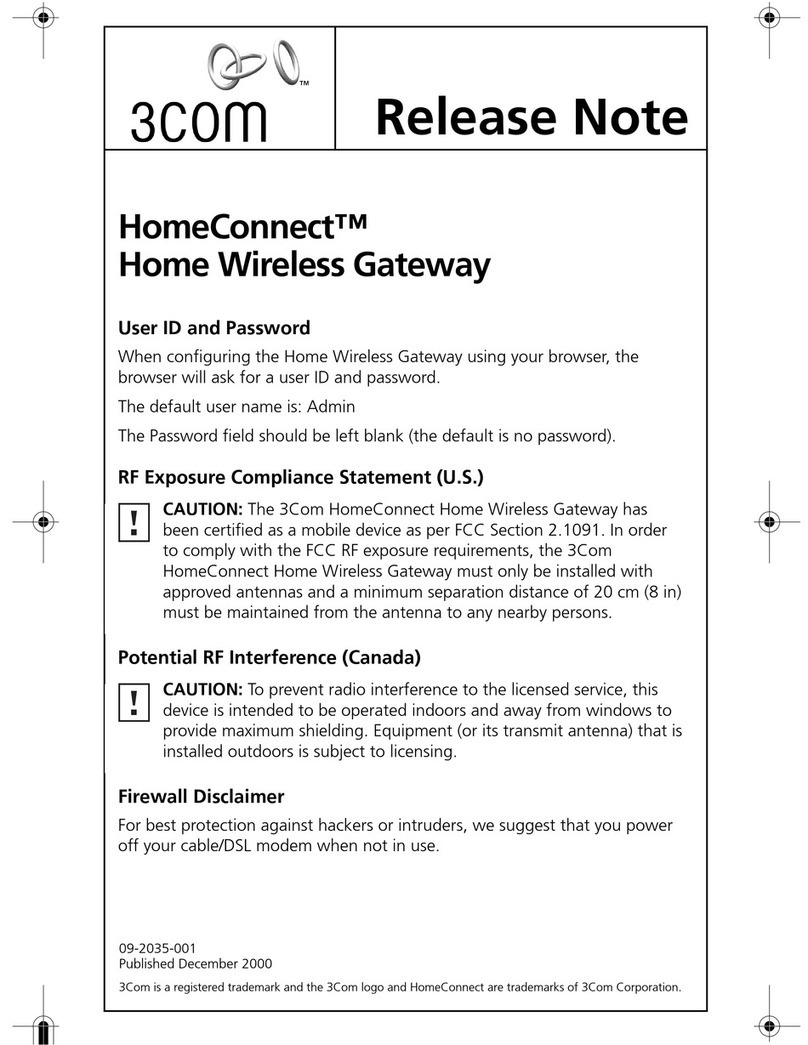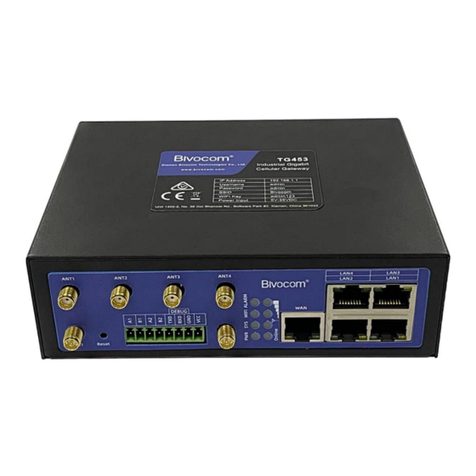Harmonic NSG 9116 Manual

Narrowcast Services Gateway
NSG 9116, 9112 and 9108
Hardware Installation and Startup Guide
For NSG 9100 Ver. 3.0
P/N MAN-NSG9100-HW-3.0 Rev. B
February 2004

ii
Disclaimer
Harmonic Inc. reserves the right to change any products described herein at any time, and
without prior notice. Harmonic assumes no responsibility or liability arising from the use of the
products described herein, except as expressly agreed to in writing by Harmonic. The use and
purchase of this product does not convey a license under any patent rights, copyrights, trademark
rights, or any intellectual property rights of Harmonic. Nothing hereunder constitutes a
representation or warranty that using any products in the manner described herein will not
infringe any patents of third parties.
Trademark Acknowledgments
Harmonic and all Harmonic product names are trademarks of Harmonic Inc. All other trademarks
are the property of their respective owners.
Compliance and Approval
This equipment has been tested and found to comply with the limits for a Class A digital device,
pursuant to Part 15, subpart B of the Federal Communications Commission (FCC) rules.
These limits are designed to provide reasonable protection against harmful interference when the
equipment is operated in a commercial environment.
This equipment generates, uses and can radiate radio frequency energy. It may cause harmful
interference to radio communications if it is not installed and used in accordance with the
instructions in this manual. Operation of this equipment in a residential area is likely to cause
harmful interference. If this occurs, the user will be required to correct the interference at their
own expense.
Connections between the Harmonic equipment and other equipment must be made in a manner
that is consistent with maintaining compliance with FCC radio frequency emission limits.
Modifications to this equipment not expressly approved by Harmonic may void the authority
granted to the user by the FCC to operate this equipment.
The following table lists agency approvals:
Agency Approval
North American EMI FCC Part 15, subpart B, Class A
North American Safety UL, 1950, cUL 22.2 No. 950
European EMI EN55022 Class A, EN50082-1
©Harmonic Inc. 2004
ALL RIGHTS RESERVED

Table of Contents
Preface
1 Features and Specifications
Introduction . . . . . . . . . . . . . . . . . . . . . . . . . . . . . . . . . . . . . . . . . . . . . . . . . . . . . . . . .1
NSG 9100 . . . . . . . . . . . . . . . . . . . . . . . . . . . . . . . . . . . . . . . . . . . . . . . . . . . . . . .1
Management Interfaces . . . . . . . . . . . . . . . . . . . . . . . . . . . . . . . . . . . . . . . . . . . .2
NSG Backup Capability . . . . . . . . . . . . . . . . . . . . . . . . . . . . . . . . . . . . . . . . . . . . .5
Features and Specifications by NSG Model . . . . . . . . . . . . . . . . . . . . . . . . . . . . . . .5
Environmental Specifications . . . . . . . . . . . . . . . . . . . . . . . . . . . . . . . . . . . . . . . .8
Stream Processing Overview . . . . . . . . . . . . . . . . . . . . . . . . . . . . . . . . . . . . . . . . . . .9
NSG Front Panel . . . . . . . . . . . . . . . . . . . . . . . . . . . . . . . . . . . . . . . . . . . . . . . . . . . .10
Control Panel . . . . . . . . . . . . . . . . . . . . . . . . . . . . . . . . . . . . . . . . . . . . . . . . . . . .10
Front Panel LEDs . . . . . . . . . . . . . . . . . . . . . . . . . . . . . . . . . . . . . . . . . . . . . . . . .11
EIA-232 Serial Port . . . . . . . . . . . . . . . . . . . . . . . . . . . . . . . . . . . . . . . . . . . . . . .12
Air Inlets . . . . . . . . . . . . . . . . . . . . . . . . . . . . . . . . . . . . . . . . . . . . . . . . . . . . . . . .12
Back Panel . . . . . . . . . . . . . . . . . . . . . . . . . . . . . . . . . . . . . . . . . . . . . . . . . . . . . . . . .12
Power Supply . . . . . . . . . . . . . . . . . . . . . . . . . . . . . . . . . . . . . . . . . . . . . . . . . . . .13
Ethernet Ports . . . . . . . . . . . . . . . . . . . . . . . . . . . . . . . . . . . . . . . . . . . . . . . . . . .14
GbE Input Port . . . . . . . . . . . . . . . . . . . . . . . . . . . . . . . . . . . . . . . . . . . . . . . . . . .14
NSG Output Ports . . . . . . . . . . . . . . . . . . . . . . . . . . . . . . . . . . . . . . . . . . . . . . . .17
What’s Next... . . . . . . . . . . . . . . . . . . . . . . . . . . . . . . . . . . . . . . . . . . . . . . . . . . . .17
2 Cabling and Configuration
Unpacking the NSG . . . . . . . . . . . . . . . . . . . . . . . . . . . . . . . . . . . . . . . . . . . . . . . . .19
Installing the NSG . . . . . . . . . . . . . . . . . . . . . . . . . . . . . . . . . . . . . . . . . . . . . . . . . . .19
Cabling the NSG . . . . . . . . . . . . . . . . . . . . . . . . . . . . . . . . . . . . . . . . . . . . . . . . . . . .20

iv Table of Contents
Connecting the GbE Port . . . . . . . . . . . . . . . . . . . . . . . . . . . . . . . . . . . . . . . . . 20
Connecting the QAM-RF Output Cables . . . . . . . . . . . . . . . . . . . . . . . . . . . . . 21
Connecting the ASI Monitoring Port Cables . . . . . . . . . . . . . . . . . . . . . . . . . . 22
Connecting the Ethernet Cables . . . . . . . . . . . . . . . . . . . . . . . . . . . . . . . . . . . 22
Establishing Ethernet Connection . . . . . . . . . . . . . . . . . . . . . . . . . . . . . . . . . . 22
Connecting Power . . . . . . . . . . . . . . . . . . . . . . . . . . . . . . . . . . . . . . . . . . . . . . . . . . 23
Connecting the AC Power Cable . . . . . . . . . . . . . . . . . . . . . . . . . . . . . . . . . . . 23
Connecting the –48 VDC Power Supply . . . . . . . . . . . . . . . . . . . . . . . . . . . . . 23
What’s Next... . . . . . . . . . . . . . . . . . . . . . . . . . . . . . . . . . . . . . . . . . . . . . . . . . . . 24
Preliminary Configuration of the NSG . . . . . . . . . . . . . . . . . . . . . . . . . . . . . . . . . . 25
Control Panel Display . . . . . . . . . . . . . . . . . . . . . . . . . . . . . . . . . . . . . . . . . . . . 25
Control Panel Screen Concept . . . . . . . . . . . . . . . . . . . . . . . . . . . . . . . . . . . . . 26
Control Panel Operation Modes . . . . . . . . . . . . . . . . . . . . . . . . . . . . . . . . . . . . 28
Configuring the NSG . . . . . . . . . . . . . . . . . . . . . . . . . . . . . . . . . . . . . . . . . . . . . 30
Reset the NSG Unit . . . . . . . . . . . . . . . . . . . . . . . . . . . . . . . . . . . . . . . . . . . . . . 35
Monitoring the NSG . . . . . . . . . . . . . . . . . . . . . . . . . . . . . . . . . . . . . . . . . . . . . . 36
What’s Next... . . . . . . . . . . . . . . . . . . . . . . . . . . . . . . . . . . . . . . . . . . . . . . . . . . . 38
Starting the Web Client . . . . . . . . . . . . . . . . . . . . . . . . . . . . . . . . . . . . . . . . . . . . . . 38
Access Levels . . . . . . . . . . . . . . . . . . . . . . . . . . . . . . . . . . . . . . . . . . . . . . . . . . . . . 39
Entering the Monitor or Configure Access Level . . . . . . . . . . . . . . . . . . . . . . 39
Upgrading the Firmware . . . . . . . . . . . . . . . . . . . . . . . . . . . . . . . . . . . . . . . . . . . . . 40
Updating the Firmware . . . . . . . . . . . . . . . . . . . . . . . . . . . . . . . . . . . . . . . . . . . 40
3Troubleshooting
Warnings for the NSG Unit . . . . . . . . . . . . . . . . . . . . . . . . . . . . . . . . . . . . . . . . . . . 41
Alarms for the NSG Unit . . . . . . . . . . . . . . . . . . . . . . . . . . . . . . . . . . . . . . . . . . . . . 44
A Fuse Replacement
B Wiring the –48 VDC Power Supply
Getting Started . . . . . . . . . . . . . . . . . . . . . . . . . . . . . . . . . . . . . . . . . . . . . . . . . . . . . 53
Power Source Specifications . . . . . . . . . . . . . . . . . . . . . . . . . . . . . . . . . . . . . . 53
Overcurrent Protection . . . . . . . . . . . . . . . . . . . . . . . . . . . . . . . . . . . . . . . . . . . 54
Wiring Requirements . . . . . . . . . . . . . . . . . . . . . . . . . . . . . . . . . . . . . . . . . . . . . . . 54
Power Connector . . . . . . . . . . . . . . . . . . . . . . . . . . . . . . . . . . . . . . . . . . . . . . . . 55
Assembling the DC Input Power Cable . . . . . . . . . . . . . . . . . . . . . . . . . . . . . . . . . 56
Connecting the Power Cable to the NSG . . . . . . . . . . . . . . . . . . . . . . . . . . . . . . . 57

v
Table of Contents
C Advanced Fiber Optic Connections
Cascading . . . . . . . . . . . . . . . . . . . . . . . . . . . . . . . . . . . . . . . . . . . . . . . . . . . . . . . . .59
Cascading Single Channels . . . . . . . . . . . . . . . . . . . . . . . . . . . . . . . . . . . . . . . .59
Cascading Redundant Channels . . . . . . . . . . . . . . . . . . . . . . . . . . . . . . . . . . . .60
Cascading with IP Switching. . . . . . . . . . . . . . . . . . . . . . . . . . . . . . . . . . . . . . . . . . .62
Connecting a DWDM . . . . . . . . . . . . . . . . . . . . . . . . . . . . . . . . . . . . . . . . . . . . . . . .64
D Customer Support Information
Contacting Harmonic for Technical Support . . . . . . . . . . . . . . . . . . . . . . . . . . . . .67
Glossary
Index

vi Table of Contents

Preface
This guide describes the installation and startup instructions for the
Narrowcast Services Gateway family, including the NSG 9116, 9112 and
9108. The NSG is a highly integrated digital video and data gateway
between on-demand content servers and their subscribers. Designed as
a 1-RU chassis, the NSG family performs PID filtering, multiplexing,
scrambling, QAM modulation, and RF upconversion for either sixteen,
twelve or eight transport streams simultaneously. It can supply video and
other on-demand multimedia services to large numbers of subscribers.
The NSG accepts digital MPEG input through a Gigabit Ethernet (GbE)
port. The NSG directs multimedia to the different QAMs and up-
converters to create the outgoing transport streams as QAM-RF output
signals.
Note: This guide uses the term NSG to refer to the NSG 9116, 9112
and 9108.
Manual Organization
This guide is organized as follows:
■Chapter 1, “Features and Specifications,” introduces features of the
NSG.
■Chapter 2, “Cabling and Configuration,” describes how to cable and
configure the NSG.
■Chapter 3, “Troubleshooting,” describes how to resolve NSG
hardware alarms.
■Appendix A, “Fuse Replacement,” contains service information that
explains how to replace the fuse in the NSG.

viii Manual Organization Preface
■Appendix B, “Wiring the –48 VDC Power Supply,” describes how to
connect the optional –VDC power source.
■Appendix C, “Advanced Fiber Optic Connections,” describes
advanced fiber optic cabling schemes including cascading and using
a DWDM in your network.
■Appendix D, “Customer Support Information,” provides Customer
Support contact information.
■, “Glossary,” lists commonly used industry-wide terms as well as terms
used in this guide.
Conventions
This guide uses the following notational conventions:
Convention Description
Courier font regular System messages, syntax statements, or
command examples.
Courier font bold Commands that you are instructed to enter.
italic font For emphasis or command variables.
[italic font] In syntax statements, items inside brackets are
optional.
Caution: Indicates a situation that might impair data.
Note: Highlights important information.
Tip: Provides time-saving or informative suggestions
about using the product.
Warning: Indicates a situation that causes damage to the
system or might harm a person.

Chapter 1
Features and Specifications
Introduction
NSG 9100
Harmonic's NSG 9100 product line includes the NSG 9116, 9112 and
9108. The NSG provides digital video remultiplexing, scrambling, QAM
modulation, and RF upconversion for video on demand networks. The
NSG accepts digital MPEG input through 2 x GbE ports configured to
work as redundant GbE channels or as independent channels that
simultaneously receive different GbE feeds. The NSG delivers up to
sixteen transport streams through RF output ports implementing dual
upconverter technology.
The following table provides a general description of the NSG 9100
product line:

2Introduction CHAPTER 1
Note: The NSG comes with either an AC power supply or –48 VDC
power supply. All types of NSGs are intended to be installed in
restricted access locations.
Management Interfaces
Harmonic offers several methods for configuring NSG devices and
monitoring their status. All management interfaces listed below connect
to the NSG over LAN, via its ETH1 Ethernet port.
Caution: Harmonic strongly recommends using an Ethernet network
that is isolated from any other networks or subnets at your site for
management of the NSGs.It ensures adequate security, and prevents
possible disturbances to the normal operation of NSG devices due to
uncontrolled network activity.
NSG Input Output
9116 2 x GbE ports with two
modes of operation:
■two redundant
channels
■two independent ports
receiving different
feeds
8 x RF ports carrying 16 x
QAM transport streams
9112 2 x GbE ports with two
modes of operation:
■two redundant
channels
■two independent ports
receiving different
feeds
6x RF ports carrying 12 x
QAM transport streams
9108 1 x GbE port with two
redundant channels
4x RF ports carrying 8 x
QAM transport streams

3Features and Specifications Introduction
The table below lists the available management interfaces according to
the management purpose for which they are designed:
Purpose Recommended Tool
Preliminary
configuration and
monitoring of a
single NSG device
Control Panel
The NSG control panel is comprised of a display area and
key pad located on the front panel of the NSG. The control
panel is active once the NSG boots up and provides
means for preliminary configuration of a single NSG
device. It also allows you to monitor the NSG's status, view
its alarms (if present), and troubleshoot them. For details
on accessing the web client, please see the NSG Web
Client..
Configuration and
monitoring of a
single NSG device
The NSG web client is an on-board web-based user
interface, that is an integral part of the NSG firmware. The
web client is accessible through Microsoft Internet
Explorer, and provides means for configuring a single
NSG device. It also allows the user to monitor the NSG's
status, view its alarms (if present), and troubleshoot them.
For details on accessing the web client, see Chapter 2,
“Connecting Power,” .

4Introduction CHAPTER 1
Note: The MCT database is not automatically updated when an NSG is
configured using NMX or the web client. To update the MCT database,
select the NSG and execute the following command from the MCT
Actions menu: Actions > Synchronize > Get from Target.
GbE Channel Redundancy
The NSG family supports GbE redundancy to provide the network with
fault-tolerant design. The objective of the redundant channel is to
eliminate or diminish any service interruptions when an active GbE
Configuration of
multiple NSG
devices
MCT (Mass Configuration Tool).
The MCT is a spreadsheet-oriented system designed to
configure multiple NSGs simultaneously. MCT is
recommended for large-scale NSG deployments. Besides
simultaneous configuration of large number of NSG
devices, it also allows users to perform firmware upgrade
for multiple NSGs. MCT is sold separately - please contact
Harmonic Customer Support for more details.
Note: MCT is not automatically updated when an NSG is
configured through the web client. Using the web client
for configuring individual NSGs in an MCT-based site is
not recommended. If the web client is used, care should
be taken to update MCT with the changed configuration.
For details on synchronizing MCT with NSG devices,
please refer to the MCT online help.
Status and Alarm
Monitoring of
multiple NSG
devices
Harmonic NMX / 3rd party SNMP monitoring.
NMX (Harmonic's Digital Service Manager) may be used
for monitoring general status and alarms of multiple NSG
devices. A single NMX manager may be used to monitor
several hundreds NSG devices, located in several different
sites.
In addition, NSG may report its status and alarms via
standard SNMP. Any standard-based SNMP monitoring
system may be used for monitoring the status of multiple
NSG devices. This includes off-the-shelf systems such as
HP OpenView, or custom-made systems. For further
details on implementing SNMP monitoring for NSG
devices, please contact Harmonic Customer Support.
Purpose Recommended Tool

5Features and Specifications Features and Specifications by NSG Model
channel fails. NSGs with the redundancy feature do not have a primary
and secondary channel but rather have two symmetrical GbE channels.
Therefore, when a redundant channel is activated it will continue to
operate and will not revert back to the previously active channel when
that channel recovers.
Redundancy for both GbE1 and GbE2 is activated by one of two NSG
alarms:
■Chapter 3, “GbE X Link down,”
■Chapter 3, “GbE X SFP not mounted,”
Note: Automatic GbE channel redundancy is unavailable in Switching
mode. In this mode the ports are configured to work independently and
to receive different GbE feeds.
Note: Automatic GbE channel redundancy is unavailable when using
copper SFP. The redundant channel is activated only when the alarm
SFP not mounted appears. The SFP does not trigger the GbE link down
alarm.
NSG Backup Capability
The NSG includes a Non Volatile RAM (NVRAM) that is also powered by a
lithium battery. The NVRAM allows configuration backup and maintains
the NSG time.
Caution: Risk of explosion if battery is replaced by an incorrect
type. Dispose of used batteries according to the instructions.
Features and Specifications by NSG Model
The following table describes the features of the NSG 9100.

6 Features and Specifications by NSG Model CHAPTER 1
Feature Description
Chassis 1-RU, mounts in Electronic Industries
Association (EIA) standard rack
2 x GbE input ports ■Provide two redundant GbE channels, or
two independent ports receiving
simultaneously different feeds
■Max. allowed PCR jitter 10 msec (peak to
peak)
■Payload of up to 800 Mbps (up to 256
services)
■Max. Ethernet traffic (payload + pass
through traffic) 1000 Mbps
16, 12 or 8 x QAM
modulators
■QAM Mode:
■DVB (Annex A): 8 MHz
■ITU-T (Annex B J.83): 6 MHz
■ITU-T (Annex-C - Japan), 6 MHz
■QAM Constellations:
■Annex-A: 16, 32, 64, 128, 256
■Annex-B: 64,256
■Annex-C: 16, 32, 64, 128, 256
Maximum output bit rate ■DVB: 408 Mbps (51.2 Mbps x 16)
■ITU-T: 310.4 Mbps (38.8 Mbps x 16)
8, 6 or 4x RF outputs ■Each port carries two QAM channels,
combined and upconverted into two
adjacent RF channels
■Connector: F-type
■Recommended Cable: 75 Ohm, RG-6
■QAM / RF Specifications:
■see product specifications sheet
1 x ASI monitoring port ASI monitoring port can be configured to
output the same data as the RF output ports.
The ASI Port can be configured to monitor all
transports.
Front panel LEDs Power, alarm, 2 input status, and 16, 12 and 8
output status LEDs.

7Features and Specifications Features and Specifications by NSG Model
Back panel LEDs Activity and alarm LED pairs for each GbE port
(four LEDs in all).
Dynamic extraction of
input
■Dynamic detection of changes in services
and PSI tables at the input
■Automatic reflection of input changes into
the output stream within one second
Filtering of GbE input
services
Data arriving to the NSG input GbE ports is
filtered based on routing information
communicated by the video server
PID remapping PIDs of incoming services are remapped in
one of two ways (user-configurable):
■Paradigm
■Random
Motorola pre-encryption
support
Accepts Motorola pre-encrypted content
10Base-T/100Base-T
Ethernet ports
Two independent Ethernet ports, typically
used for management (ETH1) and (ETH2)
SNMP support Built-in SNMP agent communicates device
status via SNMP traps
PSI generation for each
output
Generation of PSI (PAT and PMT) for each
individual output stream
Monitoring and control Configuration, control, and monitoring by:
■Harmonic NMX Digital Service Manager
■NSG web client accessed using Internet
Explorer 5.0 to 6.0
■Massive Configuration Tool (MCT)
■Control Panel
Feature Description

8 Features and Specifications by NSG Model CHAPTER 1
Environmental Specifications
The following table lists the environmental specifications for the NSG.
Parameter Description
Dimensions
Height 4.4 cm (1.73 in)
Width 44 cm (17.3 in)
Depth 62.5 cm (24.6 in)
Operating temperature 0 to 50 °C (32 to 122 °F)
Storage temperature –40 to 70 °C (–40 to 158 °F)
Relative humidity Maximum 85% non-condensing
Ventilation If units are installed in a closed rack, the rack
must be ventilated to ensure proper cooling of
the units. Ventilation rate must be:
At least 1.0 cubic meter per minute (35 cubic
feet per minute) per NSG unit.

9Features and Specifications Stream Processing Overview
Stream Processing Overview
The NSG accepts a GbE input, and outputs analog RF. The following
diagram shows the flow of data through the GbE channel.
Note: The diagram shows the maximum output of 8 RF. NSG 9112 and
9108 output 6 or 4 analog RF respectively.

10 NSG Front Panel CHAPTER 1
NSG Front Panel
The front panel of the NSG contains the following:
■RS-232 connector - enables to connect the NSG to another PC.
■QAM Output LEDs - up to sixteen LEDs for monitoring QAM output
ports. The number of LEDs varies according to the number of QAM
output ports. In NSG 9116 there are sixteen LEDs, in 9112 twelve
and in NSG 9108 there are eight LEDs.
■Power, Alarm, Input 1 and Input 2 LEDS - enables to monitor the
status of the NSG power, alarm and input ports.
■Control panel- comprised of a display area and a keypad. The control
panel enables preliminary configuration and monitoring of the NSG.
The following figure illustrates the front panel of the NSG 9100:
Control Panel
The control panel allows you to monitor and configure the NSG. You can
start using the control panel once the NSG boots up and the Power up
screen appears in the control panel display.

11Features and Specifications NSG Front Panel
Front Panel LEDs
The following table describes the front panel LEDs, from left to right.
LED Color Description
Output Green/Red/
Orange
ON (Green) - Indicates the output port is
properly configured and has at least one
service.
ON (Red) - Indicates an output alarm has been
activated.
ON (Orange) - Indicates an output warning has
been activated.
ON (Green blinking) - Indicates the 'Identify unit'
button has been selected.
OFF - Indicates the output port has no service
or is disabled.
Power Green ON - Indicates that NSG is powered on.
OFF - Indicates that NSG is powered off.
Alarm Red/Orange ON (Red) - Indicates an alarm has been
activated in the device.
ON (Orange) - Indicates a warning has been
activated in the device.
Refer to Chapter 3, “Troubleshooting,” for
further details.
OFF - Indicates no alarm activated.
Input Green/Red/
Orange
The first LED shows the status of GbE channel
1, and the second LED shows the status of GbE
channel 2.
ON (Green) - Indicates the input port is enabled
and has a valid GbE signal.
ON (Red) - Indicates an input related alarm has
been activated. The activated LED indicates the
specific port with the alarm.
ON (Orange) - Indicates an input related
warning has been activated. The activated LED
indicates the specific port with the warning.
ON (Green blinking) - Indicates the 'Identify unit'
button has been selected.
OFF - Indicates the input port is disabled.

12 Back Panel CHAPTER 1
EIA-232 Serial Port
The EIA-232 serial port may be used to configure the Ethernet port IP
addresses. You can use the serial port for monitoring and manual
maintenance operations. The EIA-232 serial port has a female DB-9 D-typ
connector.
Air Inlets
Air inlets are located along the lower, upper and right middle parts of the
NSG front panel. The air inlets are designed to provide maximum air flow.
Back Panel
This section describes the back panel of the NSG. The back panel of the
NSG 9116, 9112 and 9108 differ in the number of RF output ports only.
The NSG 9116 has eight RF output ports, as the following figure
illustrates. NSG 9112 has six output ports and NSG 9108 has four output
ports.
The NSG back panel has one ASI output port and two Gigabyte Ethernet
(GbE) receptacles for Small Form Factor Pluggable (SFP) transceivers.
This manual suits for next models
2
Table of contents
Other Harmonic Gateway manuals
